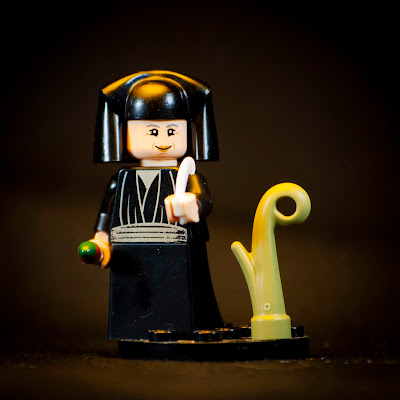St. Catherine of Alexandria
St. Catherine of Alexandria, whether or not she was a single historical figure (there's plenty of debate about how mythologized she is and whether she way have been multiple stories combined into one), was an extremely influential figure. Her name has been borrowed for everything from unmarried French girls to a mountain range to a type of firework to a CRATER ON THE MOON to numerous cities, churches, and schools to a whole string of other saints inspired by her. And once you hear her story, it's easy to see why.

Catherine was born a princess to pagan parents, her father being the governor of their region of the Roman empire. You may remember Alexandria as the place that had that really awesome library that was so cool we still haven't gotten over it 1700 years later. It's entirely possible that young Catherine was there, reading those books that have since been lost to time.
Catherine, still a child of fourteen, received a vision of the Virgin Mary and the Christ child, and converted to the Christian faith. Soon after this, the emperor (her dad's boss), started formally persecuting Christians. So, doing what any good little girl would do,Catherine hid until it died down Catherine left her home town in Egypt to rebuke the emperor in his seat in Rome. Concerned about the optics of murdering a smart, kind little girl, the emperor instead offered a debate. He arranged for fifty of his best theologians, orators, and scholars to meet with her and try to convince her to denounce her faith.
According to legend, one by one she won each debate, converting many of them to Christianity in the process. Each that converted was summarily executed.
But the emperor still didn't relent. He had Catherine imprisoned and whipped, trying to break her spirit and scar her beautiful body. Angels came to bind her wounds as Catherine took all the punishment keeping her eyes raised to heaven, being kept alive through the emperor's attempts to starve her by a dove sent by God.
As word of her resilience spread, many came to witness Catherine's miraculous strength. One such visitor was the emperor's own wife, who was so moved that she converted on the spot. The emperor had her killed.
Despite all this, the emperor's resolve to convince Catherine to renounce her faith still stood. He offered to marry her, making her the empress of Rome, the most powerful and richest woman in the world, if only she would reject Christ. Still, Catherine refused.
The emperor had finally had enough, and decided to have her tortured and killed on a spiked wheel designed to contort and twist your body in agonizing ways while slowly cutting you and breaking your bones until you could take no more and died. As she was about to be bound to the device by the executioner, Catherine touched the wheel (or it was struck by lightning, according to other accounts) and it shattered to pieces. The emperor had enough and finally ordered her beheaded. Catherine, still only 17 or 18, assented to her martyrdom. It is said that after the blade fell, milk rather than blood flowed from her neck.
Tradition says that after her death, angels carried her remains to Mount Sinai (the same place where Moses received the Ten Commandments). A few hundred years later, a monastery was built on the spot which still stands today, and allegedly contains her incorrupt remains.
Even if they aren't historically accurate, stories like these are powerful ways of telling the values of the church. St. Catherine's veneration dates back to at least the 6th century, which is itself a powerful testimony to the equality that the early church valued between women and men in contrast to the Roman culture it arose in. It's easy to forget now how influential the Church's teachings were on the ancient world, but I hate to picture what might have been if it never existed.
Join me next month for the weirder side of a saint I'm sure you all know. And good news! Next year I'm planning to start publishing two of these each month!

Lifetime: 287 to 305
Region: Alexandria, Eqypt
Patronages: Craftspeople who work with wheels (e.g., potters and spinners); lawyers; apologists; unmarried girls
Iconograpy: Wheel; Crown; Scourge
Feast Day: November 25
Catherine was born a princess to pagan parents, her father being the governor of their region of the Roman empire. You may remember Alexandria as the place that had that really awesome library that was so cool we still haven't gotten over it 1700 years later. It's entirely possible that young Catherine was there, reading those books that have since been lost to time.
Catherine, still a child of fourteen, received a vision of the Virgin Mary and the Christ child, and converted to the Christian faith. Soon after this, the emperor (her dad's boss), started formally persecuting Christians. So, doing what any good little girl would do,
According to legend, one by one she won each debate, converting many of them to Christianity in the process. Each that converted was summarily executed.
But the emperor still didn't relent. He had Catherine imprisoned and whipped, trying to break her spirit and scar her beautiful body. Angels came to bind her wounds as Catherine took all the punishment keeping her eyes raised to heaven, being kept alive through the emperor's attempts to starve her by a dove sent by God.
As word of her resilience spread, many came to witness Catherine's miraculous strength. One such visitor was the emperor's own wife, who was so moved that she converted on the spot. The emperor had her killed.
Despite all this, the emperor's resolve to convince Catherine to renounce her faith still stood. He offered to marry her, making her the empress of Rome, the most powerful and richest woman in the world, if only she would reject Christ. Still, Catherine refused.
The emperor had finally had enough, and decided to have her tortured and killed on a spiked wheel designed to contort and twist your body in agonizing ways while slowly cutting you and breaking your bones until you could take no more and died. As she was about to be bound to the device by the executioner, Catherine touched the wheel (or it was struck by lightning, according to other accounts) and it shattered to pieces. The emperor had enough and finally ordered her beheaded. Catherine, still only 17 or 18, assented to her martyrdom. It is said that after the blade fell, milk rather than blood flowed from her neck.
Tradition says that after her death, angels carried her remains to Mount Sinai (the same place where Moses received the Ten Commandments). A few hundred years later, a monastery was built on the spot which still stands today, and allegedly contains her incorrupt remains.
Even if they aren't historically accurate, stories like these are powerful ways of telling the values of the church. St. Catherine's veneration dates back to at least the 6th century, which is itself a powerful testimony to the equality that the early church valued between women and men in contrast to the Roman culture it arose in. It's easy to forget now how influential the Church's teachings were on the ancient world, but I hate to picture what might have been if it never existed.
Join me next month for the weirder side of a saint I'm sure you all know. And good news! Next year I'm planning to start publishing two of these each month!





